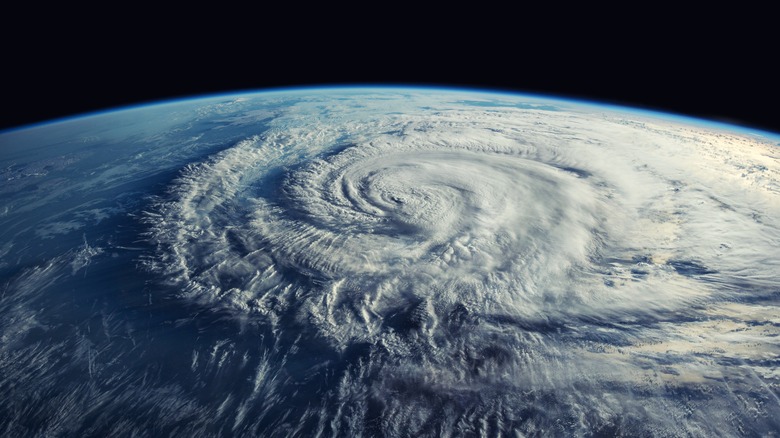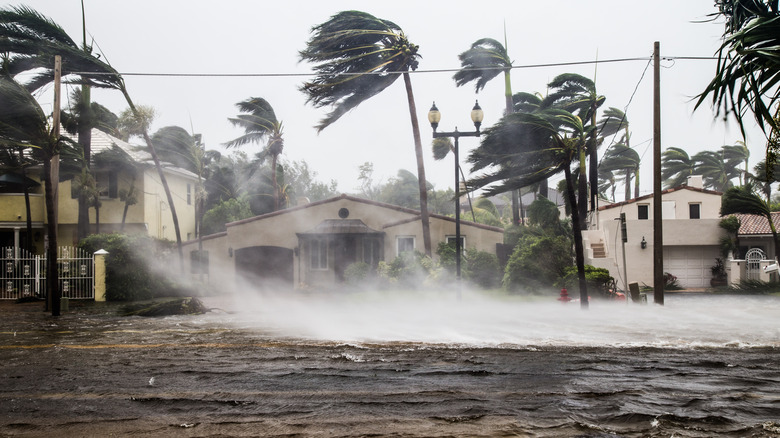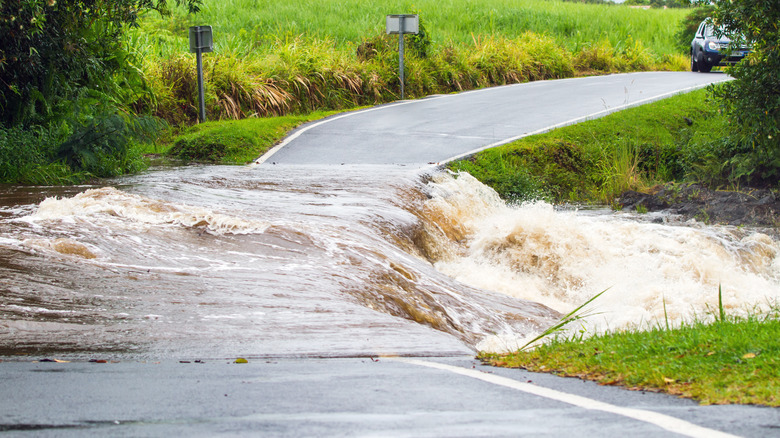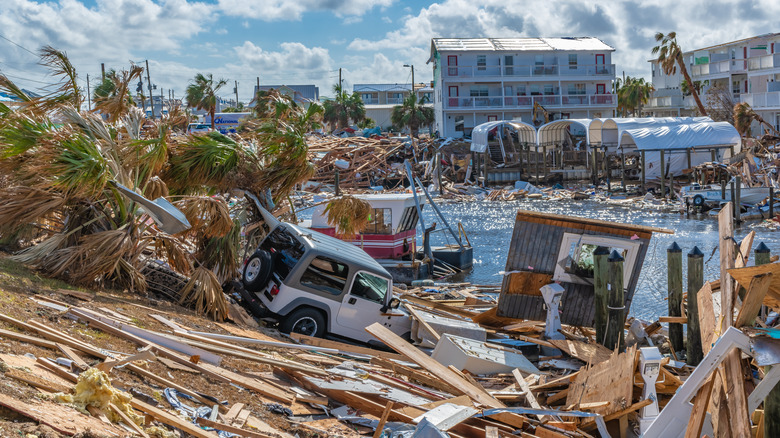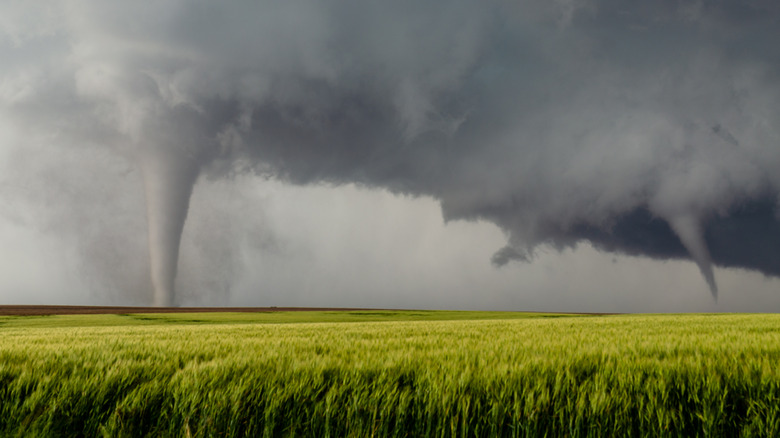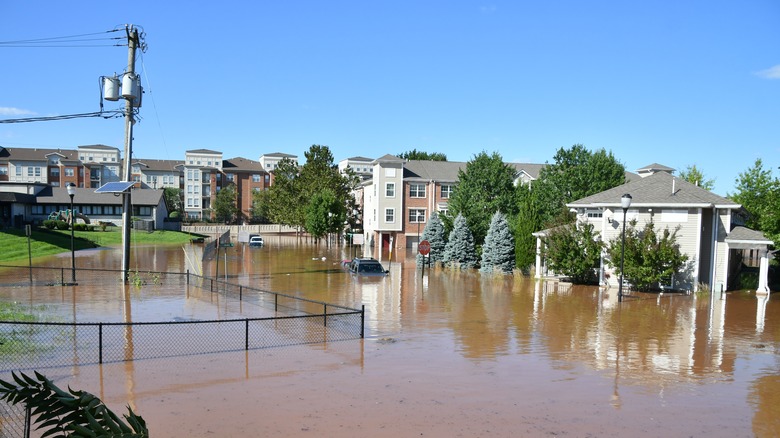What The Different Hurricane Categories Really Mean
Among weather events, nothing is as powerful and destructive as a hurricane. Since 1980 they have been responsible for more than 6,500 deaths and over $1 trillion in damages (via Office for Coastal Management). The driving force behind this devastating natural phenomenon is the humble power of wind and water.
Hurricanes form when warm, moisture-laden air rises from the ocean, leaving a zone of lower pressure in its wake. That low atmospheric pressure draws in more air which also rises, drawing more ocean moisture with it. When the warm air cools, the water it carries condenses into clouds. As more water evaporates, it feeds the winds of the growing storm (via NASA). The rotation of the Earth induces the storm's spin, and the prevailing winds of the tropics push it westward (via Hurricanes: Science and Society).
To be better able to talk about the strength and potential impacts of a hurricane, scientists use the Saffir-Simpson Hurricane Wind Scale. The scale goes from 1 to 5 and is based on the maximum sustained wind speed of the storm. Even before these tropical cyclonic storms are officially deemed hurricanes, their wind speed and rainfall are a force to be reckoned with.
Against the wind
The power of the wind is often underestimated, especially by those who have never experienced its destructive capacity. A wind speed over 25 mph is strong enough to snatch an umbrella from your hands. At over 40 mph walking becomes difficult and a storm will be given a name, but it's still not technically hurricane. As wind speeds exceed 60 mph some trees become uprooted, shingles are ripped off of roofs, and waves are pushed up to 30 feet high. And yet, this still isn't a hurricane (via Royal Meteorological Society).
When the maximum sustained winds for a one-minute period from a tropical storm exceed 74 mph, it officially becomes a hurricane. Winds of this strength can tear the siding off of a house, knock over a mobile home, and snap off branches from trees. Between 96 and 110 mph is considered a category 2 hurricane. At these wind speeds, anything outside (your livestock or pets) is at serious risk of being fatally injured by flying debris (via National Hurricane Center).
When a storm's intensity reaches category 3 (111–129 mph) the damage from wind and wind-borne debris will be so extensive that roads will be blocked and basic utilities won't be available for days or weeks. At category 4 (130–156 mph) the destruction is so extensive that impacted areas will be uninhabitable. Winds in a category 5 storm are so strong that nothing but rubble is left in its wake.
Water dissolving and water removing
Hurricanes derive their power from the evaporation of warm waters over the open ocean. This water manifests itself as clouds, spinning around the hurricane's eye. When those clouds disgorge themselves over land, torrential rains are unleashed, causing flooding and landslides. And contrary to the punishing winds of a hurricane, which can be highly localized, rainfall brought by a hurricane can extend over 200 miles from the eye and persist for over 24 hours (via Atmospheric Research).
Even though a hurricane's wind and potential rainfall are fueled from the same source, the connection between intensity and rainfall is weak (via Journal of Applied Meteorology and Climatology). Having said that, hurricanes, no matter the size or intensity, typically produce between 6 and 12 inches of rain.
The wettest hurricane in U.S. history was Hurricane Harvey which dumped up to 60 inches of rain in some parts of Texas over seven days in 2017. The next wettest was Hurricane Florence which hit North Carolina the following year with peak rainfall of over 35 inches. Florence made landfall as a category 1 hurricane and yet it outclassed every hurricane in history except Harvey which landed as a category 4. And even though excessive rain may sound like a mere inconvenience, of the 90 deaths directly attributable to these two hurricanes, over 90% of them were due to freshwater flooding.
Where the wind meets the waves
Although the wind can be as gentle as a breeze, we've seen how it can be strong enough to flatten a house. It's also strong enough to move oceans. As hurricanes traverse the seas, their high winds push ocean water ahead of their path. As the elevated deep-ocean water approaches land and passes over the continental shelf, the storm-driven water rises up in a storm surge, inundating coastal land (via National Hurricane Center).
As that water washes ashore, it can wash away beaches, permanently changing the coastline. Water weighs over 64 pounds per cubic foot, and as that weight crashes into infrastructure, buildings and roads are literally swept away. Storm surges can be as tall as 30 feet and extend inland for miles, compounding any consequences of torrential rains. The deadliest and costliest hurricane in living memory — Katrina — can credit storm surge with the majority of its carnage.
Because the root of a storm surge's power lies in the monstrous force of hurricane winds, you would think that the Saffir-Simpson scale would be a good metric by which to predict storm surge levels. Unfortunately for meteorologists, that's not the case. Hurricane Ike made landfall as a category 2 storm and produced a surge of 20 feet while category 4 Hurricane Charley only produced an eight-foot surge.
Vortex pulls me in, the vortex spits me out
If hurricanes are the apocalypse, then tornadoes are the final horseman. As residents of the midwest are well aware, tornadoes are scary. Besides being able to generate hurricane force winds on a footprint smaller than a gas station (via National Weather Service), they're nearly impossible to predict and this is what makes them so dangerous. A hurricane you can see coming days in advance and you can prepare yourself. At best, a tornado gives you 10 minutes warning before it's on top of you.
To make a tornado, you need a thunderstorm (via Popular Mechanics), and it just so happens that hurricanes are basically an amalgamation of thunderstorms. Not all hurricanes produce tornadoes but some — like Hurricane Ivan — can produce more than 100 over a broad geographical area days after their landfall, leaving billions of dollars in damages in their wakes.
The good news is that in general, hurricanes don't produce very powerful tornadoes. The bad news is that even the weakest tornadoes can produce hurricane-force winds. There also doesn't seem to be a direct connection between the strength of a hurricane and the number of tornadoes it produces so the Saffir-Simpson scale can't help us predict the extent of a tornado outbreak (via Geographical Review).
Is it time for a new scale?
The beauty of the Saffir-Simpson scale is its simplicity. Before it became widely adopted, meteorologists compared current storms to previous storms to help the public prepare for their impact. In 1969 Herbert Saffir developed a scale to describe a hurricane's potential damage to infrastructure. A few years after that, Robert Simpson modified the scale so it was based on the more quantifiable metric of wind speed (via History).
Even though the current scale used to measure hurricanes is easy to understand, it's not necessarily indicative of how destructive a storm is going to be. Comparing Hurricanes Andrew (category 5 landfall) and Irma (category 4 landfall) is illustrative of the shortcomings of the Saffir-Simpson scale. Although Andrew caused a not-inconsiderable $26 billion in damages, the "weaker" Irma caused up to $65 billion in damages.
One potential replacement for the scale is the Cyclone Damage Potential Index which looks not only at the maximum wind speed of a hurricane, but also at the extent of its winds, its size, and its speed. Using this metric (which ranges from 1 to 10), Andrew clocks in at 2.9 and Irma more than doubles it at 5.9 (via Washington Post). Still, Saffir-Simpson has inertia. Although meteorologists continue to debate the issue, we'll probably continue to use the five-point scale for the foreseeable future.
